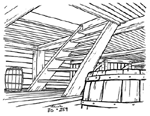A layout involves not just the background drawing but also the posing of the character within the scene, and the technical information needed for shooting the scene such as field size and any camera moves.
The layout artist refers to the location designs and prop designs as a guide to the proportions and spatial relationships of all the objects within the environment. They then look at the storyboard panels for the character placement, action, and camera angle for each scene.
The layout artist then decides on the field size for the scene. The field size refers to the area on the paper that the camera is actually going to see for the final shot. Typical field sizes will range from 6 fld to 12 fld depending on the type of shot. A 6 fld is usually used for close ups and 12 fld is used for long shots.
Depending on the type of shot, the layout artist may start by drawing the character pose and then move on to the background layout. They usually do a very rough sketch and then get it approved by the layout supervisor or director before moving on to the clean up stage. Depending on the type of production, the budget and the studio's methodology there may be several versions of the layout drawn and then a final layout chosen for the scene. In some cases, after the layout drawing is completed, a tonal rendering may be done to give the background artist a better sense of the lighting for that particular scene. This is usually done by a separate person rather than the layout artist.
The layout background and animation poses may then be shot and timed to go into the story reel to replace the storyboard panels. This will give the director a more finished idea of what the film will look like before moving into animation.
Click on each of the thumbnails shown here to see the layout and read some more about each one.
Back to the Animation School Index













